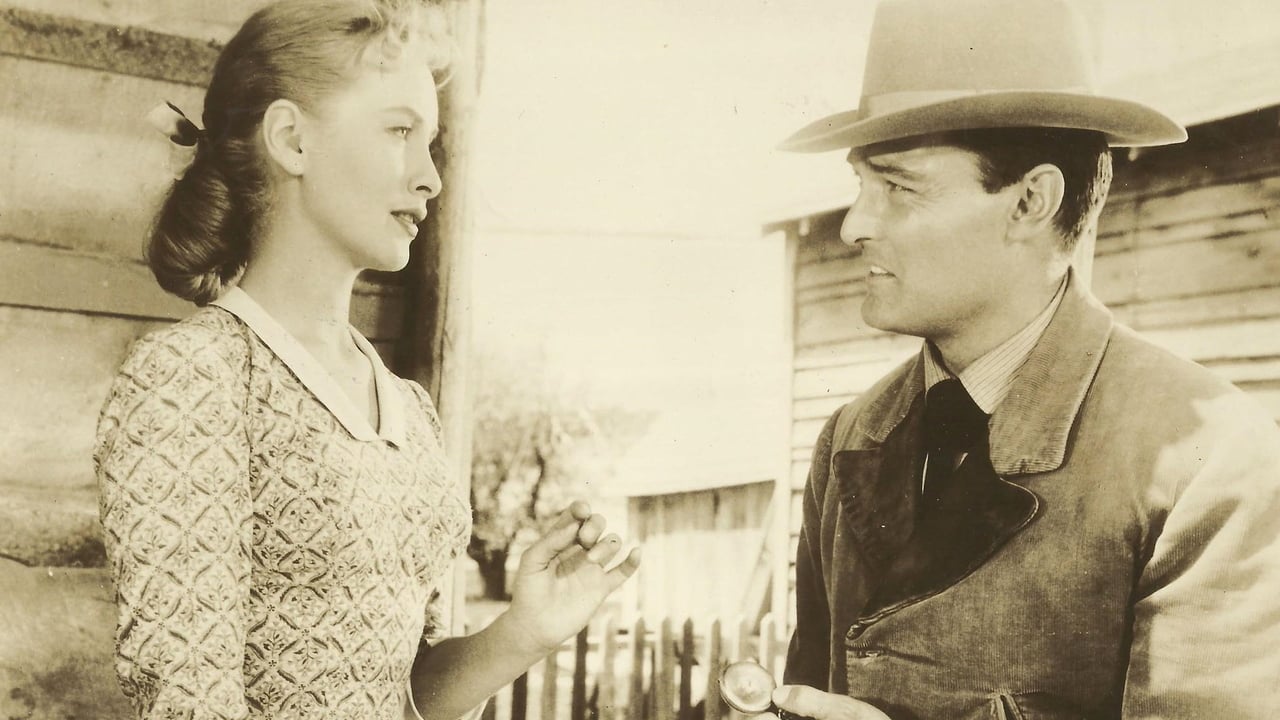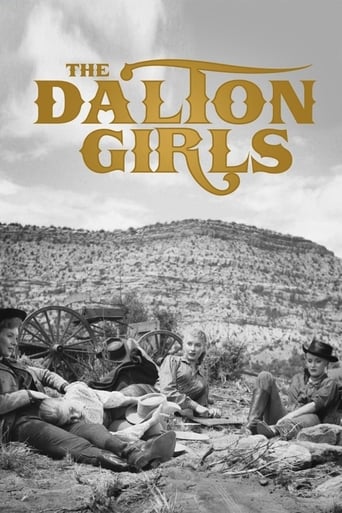

"The Dalton Girls" is NOT "Bad Girls", it is a totally different film than the 1994 Stowe, Barrymore, Masterson, MacDowell film. Basically the only things they have in common are: 1: There are four women involved, and spoilers ahead: 2: A bad guy was killed because he tried to abuse a woman, so he got killed. 3: Something I will save for last. I have to say, it is a much harsher film than "Bad Girls", because the worst of the "Bad Girls" Lilly (Barrymore), was not a cold blooded killer in the way that Rose, and even Holly are. Another factor that makes it harsher (MAJOR Spoilers ahead)is the fact that Rose and Marigold die, Holly surrenders (and you know will be hanged), and only Columbine escapes the fate of her sisters, because she will not kill unarmed men (Including "Illinois"), and saves them from getting murdered, so I guess for that reason, the town let "Illinois" take her away. By comparison, the "Bad Girls" all get away, with Cody (Stowe), Anita (Masterson), & Lilly going off to dig for gold, with Eileen (MacDowell), staying behind to get married and help run a ranch. "The Dalton Girls" is a very good film, and worth watching (Although it is not the modern classic "Bad Girls" is). The one character in "Bad Girls" you see a lot of in "The Dalton Girls" is Eileen. She has elements of three of the Daltons. 1: She has regrets like Holly did of her choices in life. 2: Instead of living an outlaw life, She wants to ranch and be married (Like Marigold). 3: She is the one who is willing, and eventually will separate from the others, as Columbine did. What is different, of course, is Eileen's fate is much better than any of the Daltons.
... View More"Voodoo Island" director Reginald Le Borg's vastly underrated movie "The Dalton Girls" is a surprisingly entertaining distaff western about the notorious outlaw gang's offspring. Indeed, this oater looks like a forerunner of Jonathan Kaplan's "Bad Girls" (1994) with Madeleine Stowe, Mary Stuart Masterson, Andie MacDowell, and Drew Barrymore. Unlike "Bad Girls," "The Dalton Girls" features a cast of largely unknown actresses. The most recognizable name belongs to venerable western character actor John Russell. "El Alaméin" scenarist Herbert Purdom wrote the story while seasoned western scribe Maurice Tombragel penned the screenplay. Although there are no surprises in this modest but well-staged dust-raiser, the cast and the characters are endowed with a modicum of depth and the dialogue is sometimes quite striking. Anybody who appreciates a solid, interesting western will enjoy this 71-minute shoot'em up. The priority of the themes here is women versus men, women versus society, and women versus women. The girls quarrel about their predicament, but they have their hands full of unsavory gents. Producer Howard W. Koch went on to produce several Frank Sinatra epics, including "Sergeants 3," "Robin and the Four Hoods," "Four for Texas," and "None but the Brave." The action opens with the Dalton brothers getting cornered on the prairie and gunned down. If you look closely, their body positions change after they hit the dirt. Nevertheless, Mr. Slidell, the Mortician (Glenn Dixon of "Untamed Youth") puts their bodies on display in the back of his undertaking parlor for twenty-five cents. Later, when the two older sisters, Holly (Merry Anders of "Women of the Prehistoric Planet") and Columbine (Penny Edwards of "Missing Women"), visit the funeral home, Slidell talks about defraying the expenses of the funeral and tries to rape Holly. She clobbers him with a shovel, but she hits him hard enough that he dies. Earlier, a private detective name Hiram Parsh (Ed Hinton of "Jungle Moon Men") had stopped by to identify the bodies. Slidell refused to let him view the corpses until he paid his quarter because the undertaker didn't consider him in the same position as a public servant. Just so that we the audience know that Slidell is unsavory, Parsh drops his quarter in the dirt.Six years elapse and the Dalton girls hold up a stagecoach. One of the passengers tries to get fresh with Columbine and she pulls her pistol on him. W.T. "Illinois" Grey (John Russell of "Pale Rider") takes an instant liking to Columbine. Grey is a well-dressed gambler and he isn't exactly a hero, but neither is he a villain. Columbine is taken by his attention. The two older sisters Holly and Rose (Lisa Davis of "Baby Face Nelson") are hard-bitten, especially Rose who shows no qualms about killing. Columbine accuses her Rose of killing the same way that some women love.After the stagecoach robbery, they are looking for somewhere to go and Columbine remembers that Grey mentioned something about the gold strike in Dry Creek. They show up in Dry Creek and rob the bank of $6-thousand and coincidentally Grey catches them in the act because he is trying to collect a gambling debt from the bank manager Mr. Sewell (Malcolm Atterbury of "The Birds") who is somewhat shady. During the hold-up, Sewell grabs a gun in his desk drawer and Rose plugs him. She shoots Grey, but her bullet glances off the watch that the gambler wears and he survives the murder attempt. Columbine isn't happy about this turn of events. The sisters skedaddle and wind up in Tombstone. Grey trails them to Tombstone and a suspicious Parsh follows him.In Tombstone, Grey corners Rose and Holly in a saloon where they are working as hostesses and threatens to reveal their identities unless they give him his six grand. They concoct a scheme to rob a poker game. You see, the bigger poke games are private and Sheriff St. Ives (stunt man Al Wyatt, Sr.) guards the hotel room where the men play. The Dalton sisters get the drop on St. Ives and rob the game, but they don't get far because Parsh opens fire on them.One of the neat touches here is a song that Rose sings about how her six-gun is more dependable to her than a man. The lyrics go something like this . . . "Oh, you can't trust a man, cause a man will lie, but a gun stays beside you till the die you die." Director Le Borg does a good job of keeping the action moving along at full tilt so that there are no lulls in the action. The film appears to have been done on location, a factor that enhances its authenticity. The four sisters are differentiated in tone, dialogue, and character. "The Dalton Girls" may be a low-budget, B-western, but it never wears out its welcome and there is nothing unintentionally funny. Russell is usual stalwart self in a less than heroic role, considering that he starred as the title character in the television series "Lawman."
... View MoreLike Howard Hughes' "The Outlaw" (1943), "The Dalton Girls" (1957) was a mixed genre film; a standard "B" western with very deliberate exploitation elements. Although both films attempted a tie-in to real western history, "The Dalton Girls" wisely soft-peddled this element; the only connection being that the four girls were sisters of the guys who started the Dalton Gang.Although almost any "B" western fan will enjoy the film, it is a must see for those who get off on cowgirls in tight jeans and gun belts. That was the film's drawing card at the time of its release and even today it doesn't get any better than Merry Anders, Lisa Davis, and Penny Edwards robbing stagecoaches and banks. Edwards is my all-time favorite cowgirl and does all the difficult riding stunts in the film. There is even a scene where she hogties a teenage boy. The film also features John Russell (who would soon star in his own television show, "Lawman") as an early anti-hero. He is an interesting mix of Richard Boone's "Paladin" character (tough but philosophical) and Bret Maverick (a calculating realist of a gambler). Sam Rolfe may have seen this film in pre-release and incorporated some of Russell's traits into the "Paladin" character he was creating. Oddly, the character's name is W.T. (Illinois) Grey but he claims New Orleans as his hometown. "The Dalton Girl's" moves along nicely and then kind of clunks to a stop with an extremely lame and rushed ending. The screenwriter (Maurice Tombragel) obviously had a lot of fun with this adaptation, and the story operates on two levels. There are some nice self-parody elements inserted throughout the story. The best is a scene where Lisa Davis is singing about how having a gun is better than having a man:"Oh you can't trust a man, because a man will lie. But a gun stays beside you, until the day that you die. Oh a man is a cheater, with his trifling ways. But a gun's always faithful, because a gun never strays. Oh a man is unfaithful, he will lead you to strife. But a gun is my true love, yes a gun is my life".Then again, what do I know? I'm only a child.
... View MoreActually this is not a half-bad Western if you're not expecting much, and certainly the title doesn't promise much in the way of artistry. What this B-flick has going for it are some well- staged scenes on the prairie and a couple of tough-minded chick scenes, especially the robbery episodes. The acting is uneven, to say the least. Merry Anders is fine as Holly, the leader, as is Lisa Davis as Rose, the second toughie. However, poor Sue George as Marigold should have auditioned for Leave It to Beaver. Maybe you won't have as much trouble as I did telling these "flowers" apart, but they do look alike and it can get confusing. Judging from the title, you'd probably expect more titillation than there is-- after all, this is the 1950's. Nonetheless, there is a legitimate feminist undercurrent even if much is compromised in the end. All in all, this minor production from a couple of old pro's (director Le Borg and producer Schenck) remains a rather interesting artifact as well as a fairly viable piece of period entertainment.
... View More